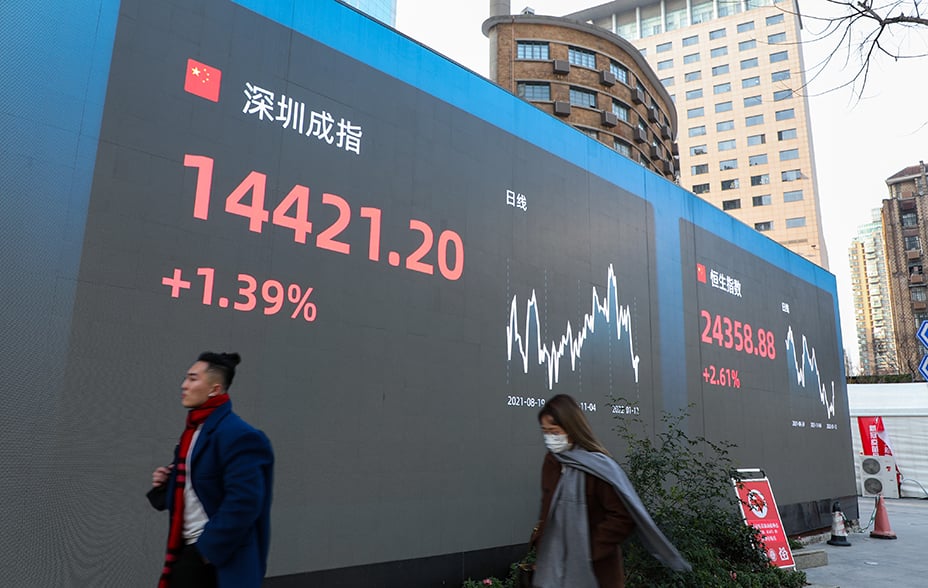
The value of an investment, and any income from it, can fall as well as rise and investors may not get back the amount invested.
The year 2021 provided no shortage of events and developments to galvanise news headlines. From rising inflation to speculation about interest rate hikes and central bank tapering, Chinese regulation, supply chain disruption and emerging variants of Covid-19, it wasn’t necessarily easy to be a long-term optimist last year. These concerns created uncertainty which, as you will be aware, markets dislike. They therefore resulted in volatility and an environment where the short-term focussed investment market often overlooked company fundamentals.
This is not the best background for our investment style which is grounded in a belief that share prices follow fundamentals, and is focused on what might go right in the long term, rather than what might go wrong over the short term. That said, while the fund underperformed the benchmark over the year, it delivered a positive absolute return. If ’growth’ investing is not in favour or short-term sentiment swings away from the companies in which we invest, then we will experience weakness and we must be upfront about that. You can be reassured though that we will not diverge from our tried and tested investment approach. We know that style drift is destructive – both in terms of deviating from investor expectations and the costs this can incur. Indeed, it is the consistency of our philosophy and process which has positioned the fund well over the long term and, despite ups and downs along the way, generated a return of 9.8 per cent per annum net of fees since 1987.
Our experience in running the Managed Fund for nearly 35 years has taught us the futility of trying to predict short-term market gyrations or macroeconomic events. Simply put, it is not in our skillset to make these forecasts. The volume of experts confounded by the Bank of England‘s decision to not hike interest rates in November is a testament to the difficulty of this. It is not to say we ignore the broader marketplace but that relevant issues are considered on a company-by-company basis (or country-by-country basis in the case of government bonds), in the context of a five-year-plus investment horizon. For example, in light of higher inflation and the potential for interest rate hikes, we seek to ensure companies in the fund have pricing power to support continued growth, and look to understand to what extent balance sheets are vulnerable to rising rates. We won’t always be right but we believe that, over the long term, the number of mistakes will be greatly outweighed by the volume of our successes.
However, for those newer investors in the fund, of which we know there are a great many, all of this might sound well and good but the long term doesn’t mean a great deal when you’ve been invested for 12 months or less and experienced weakness. It is by no means our intention to detract from your concerns. Before delving into recent performance in detail though, it is important to reiterate that resilience is required when investing. We have seen this throughout the fund's history.
There are two ways of looking at this; the absolute returns generated by the fund and performance relative to our peer group.
The first chart below shows the range of absolute returns to the end of December 2021. The first column shows the maximum and minimum return generated over any one-year period since 1987 – from -23 per cent for the 12 months to end Q1 2003 to +48 per cent over the 12 months to end Q1 2021. The second column shows the range of returns over every three-year period since inception, from -11 per cent p.a. for the three years to end Q1 2003, to +23 per cent p.a. over the three years to end Q4 1993. The same data is then shown for five, 10 and 20-year timeframes. What is quickly discernible is that the range of returns is wide over any one-year period. The reality is what happens over such short time frames is largely random. But, importantly, what this chart shows is that the range of returns narrows over time and, crucially, skews to the upside, ie to positive returns, net of fees.
Range of absolute returns over rolling periods (annualised)
Source: StatPro. As at 31 December 2021. Net of fees. The figures above show results after analysing annualised returns over each quarter for the Baillie Gifford Managed Fund 31 March 1987 to 31 December 2021.
The same trend is evident when looking at performance relative to our peer group in this second chart. We need to be absolutely clear this analysis provides no promises about the shape of future returns. However, from nearly 35 years of data, we can infer the necessity to focus on periods of five-years-plus when assessing performance. We appreciate the intervening years will not always be comfortable but it is only over meaningful time frames that a company’s success can be reflected in share-price performance and we can therefore hope to generate good returns on the savings you have invested in the fund.
Range of relative returns over rolling periods (annualised)
Source: StatPro. As at 31 December 2021. Net of fees. The figures above show results after analysing annualised returns over each quarter for the Baillie Gifford Managed Fund (31 March 1987 to 31 December 2021). vs IA Mixed Investment 40%–85% Shares Sector Median (Net) (CAPS Pooled Median (NET) to 30 September 2004, IA Balanced Median Quarterly (Net) to 30 June 2009).

Performance
The fund generated a positive absolute return over the year but underperformed the peer group. The quarter was negative on both bases.
Chinese online platforms Alibaba and Tencent were among the larger detractors over the 12 months. Both have been caught up in market worries about the effect of emergent regulation and policy in China. When considering this topic, we look to avoid broad generalisations and understand the nuances of investing in China. On the one hand, the state dominates the economy but, on the other, it has given rise to some of the most innovative and entrepreneurial companies in the world. Regulation is a global, not a local issue. However, China has a greater ability to act unilaterally because of its political and legal structure. While acknowledging that there will be relative winners and losers from this environment, we see significant upside potential in both Alibaba and Tencent over the long term.
Other companies detracting from returns have been impacted by concerns about a post-lockdown slowdown in demand. In the case of video conferencing company Zoom, the market was worried about how sharp and long-lasting any slowdown might be. These are fair questions and we shouldn't be too quick to dismiss them as issues that are troubling short-term investors. However, we see little change in the long-term prospects for Zoom as online working becomes the ‘new normal’. Zalando, Europe’s largest online retailer, also falls into this category. Revenue growth has slowed from 2020 levels. However, full year guidance has recently been upgraded to an increase of 26–31 per cent in revenue year-on-year. Not bad. There are some potential headwinds ahead, including the supply chain crisis and cost inflation, but we believe the long-term opportunity remains compelling.
In some instances, however, we have seen less encouraging operational updates. Educational company Chegg falls into this category. The company has seen challenges emerge which allege that copyrighted material is appearing for free on Chegg's platform. At the same time, enrolment in college courses has fallen as people have opted to take advantage of rising wages. Chegg has, prudently in our view, resisted the temptation to make bullish short-term predictions of a bounce back in enrolment. We don't think this breaks our investment case - the ability to learn more flexibly and at a lower cost remains attractive, and Chegg is well positioned to support educational establishments deliver that to students. While Chegg is amongst the holdings to have experienced operational challenges in 2021, we would reiterate that this is normal – we don't expect every company to succeed all of the time.
Chegg and Zoom were also amongst the larger detractors from absolute returns over the final quarter of 2021, as was Moderna. That said, Moderna was a notable positive over 12 months. The company’s share price has been exceptionally volatile over the period as it is reactive to any news on the pandemic, positive or negative. The company has used promising technology to address a global problem and is now using the cash generated from its Covid-19 vaccine to build a true therapeutic platform. Despite volatility over the past month or so, Tesla also remains one of the top contributors to absolute returns over the year as operational progress has continued apace. In the face of ongoing chip shortages and supply chain concerns in the wider automotive industry, Tesla posted stronger than expected Q3 results. The extent of the company’s innovation was clear in its ability to re-write software to accommodate different semiconductors to those usually used.

Over the year, there were also strong contributions from IMCD, the Dutch chemical distributor and NIBE, which manufactures heat pumps. In the case of IMCD, in addition to continuing to complete takeover deals, the company has seen a surge in demand and margins are at a record high as it has been able to pass inflation on to consumers. We reduced the holding in the third quarter of 2021. With NIBE, much positivity has been derived from the substantial support for heat pumps and signs that penetration in domestic heating is starting to pick up. UK-listed Ashtead was also a notable positive. The industrial equipment rental and plant hire business has continued to perform strongly, supported by a buoyant US economy and the ongoing structural shift from buying to renting large equipment. Ashtead is keen to adopt greener technologies and to increase focus on reducing carbon emissions which could drive rental penetration further over the next few years. We reduced the holding in Q4 following significant outperformance.
The fund's fixed income holdings collectively delivered a negative absolute return over the year and were flat over the quarter. The fund has been (and continues to be) underweight fixed income versus the strategic allocation of 20 per cent. This is largely because of uncertainty regarding the impact of inflationary pressures on bond yields. The 12-month negative return was mainly a result of rising bond yields (ie falling prices) as concerns about inflation reared their head. This particularly impacted developed market government bond exposures in the first quarter of 2021 given exceptionally low starting yields. Performance was further affected by currency movements. Most bond exposures are overseas, and performance was therefore negatively impacted by an increase in the value of sterling versus other major currencies – again, largely in the first quarter of 2021. On the other hand, bond selection in corporate and government issuances added to returns as did carry ie income received from bonds, and narrowing spreads in corporate bonds (mainly high yield credit).

Environmental, social and governance (ESG)
When thinking about ESG, we believe the fund is well positioned. In terms of the portfolio’s carbon footprint, analysis as of end September shows it to have meaningfully lower carbon emissions intensity than a global equities index. This hasn’t been targeted but, given our style is focused on long-term outcomes for businesses, it is much more difficult to make the case for companies heavily exposed to carbon risk. However, we recognise there is a huge amount to be done to meet global aims to combat the climate crisis and that is where engagement and voting come in as we seek to understand, learn from and help the companies in which we invest. Recently, we opposed BHP’s Climate Transition Action Plan as we do not believe the company has gone far enough to align with its goal to limit heating to 1.5 degrees above the pre-industrial level. BHP has demonstrated responsiveness to shareholder engagement, and we look forward to continuing to work with the company.
What really interests us is not backward-looking data but thinking about how a company will look in five years and which businesses are proactively contributing to the decarbonisation agenda. The fund has some exposure to climate champions such as NIBE and the UK manufacturer of ventilation products, Volution, but we hope to see this grow over time and look forward to reporting to you on this basis going forward.
Transactions
Recent new purchases highlight the diversity of opportunities being identified, from UK-based Exscientia that is driving a new healthcare paradigm through the convergence of biology and technology to help address the inefficiencies in drug development, to automotive technology company Rivian and Aker Horizons, a green tech and renewables platform. Our work is also focused on the investment case for existing holdings. In some cases, our conviction in the long-term growth opportunity has reduced sufficiently that we sold completely – Zillow, the largest online real estate portal in the US and L’Oréal, the global cosmetics company are two such examples. In the case of Zillow, a wind-down of its initiative to buy and sell homes directly altered our forward-looking hypothesis and with strong competition for capital for new ideas, we decided to move on.
Outlook
Volatility is an inevitability when investing in equities (and even bonds) but if you’re willing to be patient and focus on the long term, we believe there is good reason to be positive about the future. This doesn’t mean the fund won’t experience further weakness in returns as short-term market sentiments change, often driven by unforecastable macroeconomic events. However, we are seeing industries disrupted and new technologies emerge – over the long term, we believe innovation will continue apace. To that extent, paradoxically given recent share price weakness among several holdings, we are confident about the prospects for growth given the path of positive progress we see for companies in the portfolio. We understand it won’t be comfortable during the periods of inevitable weakness, but the consistency of our approach has been central to the success of Managed Fund since 1987 and we believe will continue to be so.
| 2017 | 2018 | 2019 | 2020 | 2021 | |
| Managed Fund | 15.0 | -2.6 | 21.3 | 33.9 | 4.3 |
| IA Mixed Investment 40–85 per cent Shares* | 10.0 | -6.1 | 15.8 | 5.3 | 10.9 |
Performance source: StatPro, FE, total returns in sterling. *The manager believes an appropriate comparison for this fund is the Investment Association Shares sector median given the investment policy of the fund and the approach taken by the manager when investing.
Past performance is not a guide to future returns.
Risk factors
The views expressed in this article are those of Lucy Haddow and should not be considered as advice or a recommendation to buy, sell or hold a particular investment. They reflect personal opinion and should not be taken as statements of fact nor should any reliance be placed on them when making investment decisions.
This communication was produced and approved in January 2022 and has not been updated subsequently. It represents views held at the time of writing and may not reflect current thinking.
All investment strategies have the potential for profit and loss, your or your clients’ capital may be at risk. Past performance is not a guide to future returns.
Custody of assets, particularly in emerging markets, involves a risk of loss if a custodian becomes insolvent or breaches duties of care.
The Fund invests in emerging markets where difficulties in dealing, settlement and custody could arise, resulting in a negative impact on the value of your investment.
Bonds issued by companies and governments may be adversely affected by changes in interest rates, expectations of inflation and a decline in the creditworthiness of the bond issuer. The issuers of bonds in which the Fund invests, particularly in emerging markets, may not be able to pay the bond income as promised or could fail to repay the capital amount.
The Fund’s share price can be volatile due to movements in the prices of the underlying holdings and the basis on which the Fund is priced.
Any stock examples and images used in this article are not intended to represent recommendations to buy or sell, neither is it implied that they will prove profitable in the future. It is not known whether they will feature in any future portfolio produced by us. Any individual examples will represent only a small part of the overall portfolio and are inserted purely to help illustrate our investment style.
This article contains information on investments which does not constitute independent research. Accordingly, it is not subject to the protections afforded to independent research and Baillie Gifford and its staff may have dealt in the investments concerned.
All information is sourced from Baillie Gifford & Co and is current unless otherwise stated.
The images used in this article are for illustrative purposes only.
Baillie Gifford & Co and Baillie Gifford & Co Limited are authorised and regulated by the Financial Conduct Authority (FCA). Baillie Gifford & Co Limited is an Authorised Corporate Director of OEICs.
Ref: 14507 10006455




